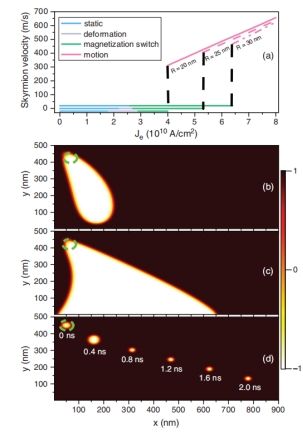Recently, the research group of Dr. Hang Li from School of Physics and Electronics has made new progress in the field of magnetism. The related paper entitled Skyrmion battery effect via inhomogeneous magnetic anisotropy has been published in the Applied Physics Reviews (https://doi.org/10.1063/5.0035622).
The postgraduate Xiawei Hao is the first author, and Prof. Zhenxiang Cheng and Dr. Hang Li are the co-corresponding authors of the paper. Henan University is the first signature organization. Prof. Aurelien Manchon from the University of Marseille in France and Dr. Fengjun Zhuo from the King's University of Science and Technology in Saudi Arabia also participated in the research.

FIG. 1. Skyrmion creation and motion in a rectangle nanostrip under a polarized spin current. The dimension of the nanostrip is 900 nm 500 nm. The skyrmion is generated in a disk-shape area located at the upper-left corner of the rectangle. This area has a lower Ku ~0.1 than the rest of the nanostrip where Ku ~0.3. (a) Skyrmion velocity as a function of spin current density for various diameters of the disk, 40 nm (solid pink), 50 nm (dashed pink), and 60 nm (dash-dotted pink). (b) Profifile of the z-component of the magnetization of the deformed vortex. (c) Magnetization switching due to the expansion of the deformed skyrmion. (d) Snapshot of skyrmion motion at different moments. Thickness of the FeGe strip is 7.5 nm and D=1.0 J m-3 . The nanostrip is prepared in a ferromagnetic initial state with a skyrmion at the defective area. The spin polarization of the current is along z. The green circle refers to the position of defect in the nanostrip.
500 nm. The skyrmion is generated in a disk-shape area located at the upper-left corner of the rectangle. This area has a lower Ku ~0.1 than the rest of the nanostrip where Ku ~0.3. (a) Skyrmion velocity as a function of spin current density for various diameters of the disk, 40 nm (solid pink), 50 nm (dashed pink), and 60 nm (dash-dotted pink). (b) Profifile of the z-component of the magnetization of the deformed vortex. (c) Magnetization switching due to the expansion of the deformed skyrmion. (d) Snapshot of skyrmion motion at different moments. Thickness of the FeGe strip is 7.5 nm and D=1.0 J m-3 . The nanostrip is prepared in a ferromagnetic initial state with a skyrmion at the defective area. The spin polarization of the current is along z. The green circle refers to the position of defect in the nanostrip.
Magnetic skyrmions are considered a promising candidate for the next-generation information processing technology. Being topologically robust, magnetic skyrmions are swirling spin textures that can be used in a broad range of applications from memory devices and logic circuits to neuromorphic computing. In a magnetic medium lacking inversion symmetry, magnetic skyrmion arises as a result of the interplay among magnetic exchange interaction, Dzyaloshinskii-Moriya interaction, and magnetic anisotropy. Instrumental to the integrated skyrmion-based applications are the creation and manipulation of magnetic skyrmions at a designated location, absent any need of a magnetic field. In this paper, we propose a generic design strategy to achieve that goal and a model system to demonstrate its feasibility. By implementing a disk-shaped thin film heterostructure with an inhomogeneous perpendicular magnetic anisotropy, stable sub-100-nm size skyrmions can be generated without magnetic field. This structure can be etched out via, for example, focused ion beam microscope. Using micromagnetic simulation, we show that such heterostructure not only stabilizes the edge spins of the skyrmion but also protects its rotation symmetry. Furthermore, we may switch the spin texture between skyrmionic and vortex-like ones by tuning the slope of perpendicular anisotropy using a bias voltage. When embedded into a magnetic conductor and under a spin polarized current, such heterostructure emits skyrmions continuously and may function as a skyrmion source. This unique phenomenon is dubbed a skyrmion battery effect. Our proposal may open a novel venue for the realization of all-electric skyrmion-based devices.
The research work is supported by the National Natural Science Foundation of China and Henan University.
Applied Physics Reviews is a top journal owned by the American Institute of Physics. The latest published impact factor of the journal in 2020 is 17.054.
The link to the paper is https://aip.scitation.org/doi/10.1063/5.0035622.
Contribution: School of Physics and Electronics

 News /
Content
News /
Content


